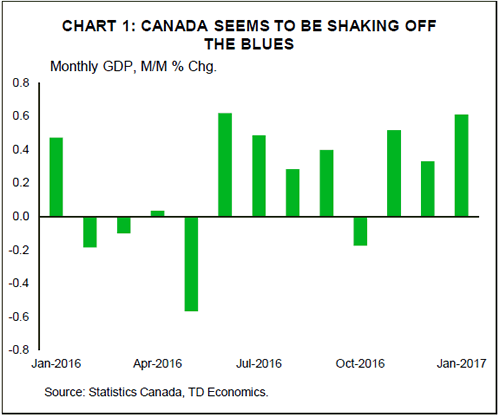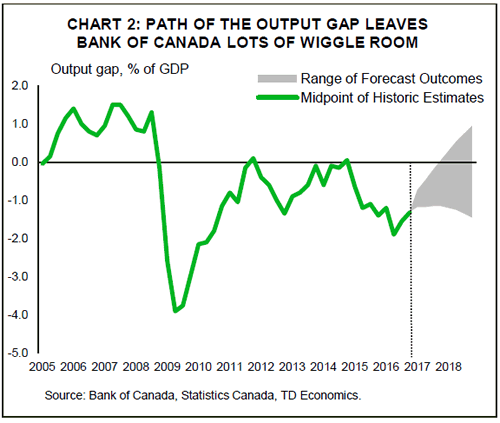HIGHLIGHTS OF THE WEEK
United States
- Following the failure to repeal and replace the ACA, market participants questioned the new administration’s ability to move forward with pro-growth policies. As such, major indicators opened lower on Monday, but risk sentiment recovered quickly as the week progressed.
- Positive developments included pending home sales data and an upward revision to fourth quarter GDP growth. Conversely, new data pointed to a deceleration for real consumer spending growth to below 1% (annualized) this quarter. That said, this appears to be only a temporary setback.
- Much of the recent sentiment uptick is related to the anticipated implementation of pro-growth policies. There are certainly risks on this front, suggesting that the Fed’s ‘wait and see’ approach is the right one as far as baking in any potential impact on the economy.
Canada
- The Canadian economy started 2017 with a bang as GDP rose 0.6% month-over-month in January on broad-based strength.
- This sets the stage for another strong quarter of economic growth. TD Economics is currently tracking a 3.4% (q/q annualized) pace of economic expansion to start 2017, which would mark the best start to a year since 2013.
- Despite an improvement in the economic backdrop, recent Bank of Canada communication has remained dovish in tone. This seems to be due to the level of economic slack, which will take time to be absorbed, resulting in limited near-term inflationary pressure. We remain of the view that the Bank of Canada is unlikely to raise rates until late 2018.
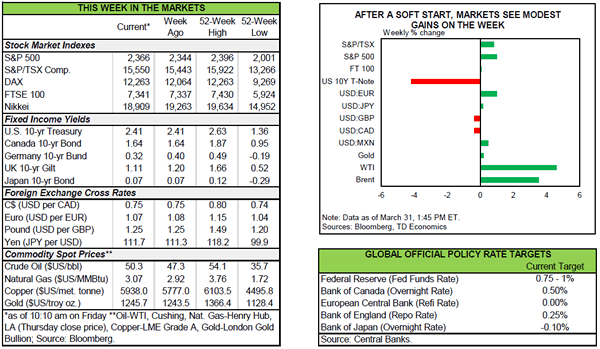
UNITED STATES – MARKETS OVERLOOKING POLITICAL SETBACKS
The failure of the bill to repeal and replace the ACA last Friday set the tone for investors at the start of this week. Market participants questioned the new administration’s ability to build consensus and move forward pro-growth policies, with major U.S. stock indices along with the greenback and long-term government rates opening lower on Monday. But, risk sentiment recovered as the week progressed, with most aforementioned indicators recovering beyond last Friday’s levels (Chart 1). This was despite the triggering of Article 50 – the official initiation of the long divorce proceedings between the U.K. and E.U. – which has been largely anticipated. The recovery was partly related to the quick pivot by the U.S. administration to other agendas, such as tax reform, with emphasis on bringing forward the infrastructure plan and some executive actions. Moreover, the data-tone also helped ease some of the concerns.
The week was relatively light as far as first-tier economic data goes. But secondary indicators, such as pending home sales looked promising, surging in February and bringing the index level to a 10-month high. Unseasonably clement weather was part of the story, with some giveback likely in March. Nonetheless, this is a welcome development as it reinforces the notion that despite rising interest rates, housing continues to contribute to economic activity given solid labor market fundamentals.
Another positive development was the upward revision to fourth quarter GDP growth. The economy expanded by 2.1% (previously reported as 1.9%) due to more strength in consumer spending – upgraded by half-point to 3.5%. After that knock-out quarter, consumers tightened their purse strings at the start of this year. Data out this morning showed that real spending fell for a second consecutive month in February, with weather and delayed tax rebates likely playing a part. As such, real consumer spending looks set to advance by less than 1% in the first quarter of 2017. Still, this is likely to be only a temporary setback. Spending should bounce back in the second quarter, thanks to strong consumer confidence and accelerating income growth, restoring economic growth to a well-above trend rate.
While the economy remains on solid footing there has been an increasing divergence between survey and sentiment metrics (soft data) and harder indicators of economic activity (i.e. sales and incomes). This narrative can be illustrated by Bloomberg’s surprise index where hard data has come in largely as expected while survey-based data has been the main thrust behind an improvement in the measure (Chart 2).
Ultimately, the strength of the economy will depend on which way the convergence will occur. Much of the sentiment uptick is related to the anticipated implementation of pro-growth policies. However, doubts as to the probability of success could quickly manifest into weaker readings. There are certainly risks on this front. For starters, tax reform is complex, and while lawmakers have some leeway, delays could put a dent in sentiment. Additionally, the failure to repeal and replace the ACA leaves the budget plan billions short, increasing the likelihood of scaled-down versions of other parts of the agenda. All told, it would appear the Fed’s ‘wait and see’ approach is the right one as far as baking in any potential impact on the economy, with the anticipated three hike per year pace seemingly appropriate for the time being.
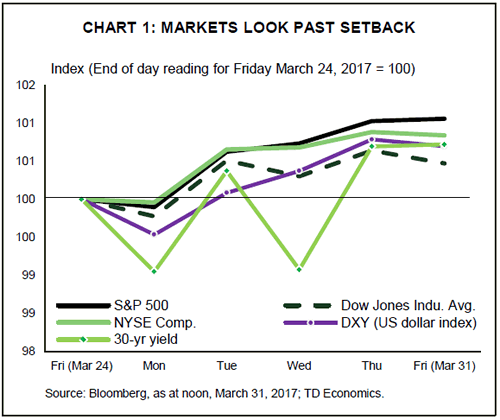
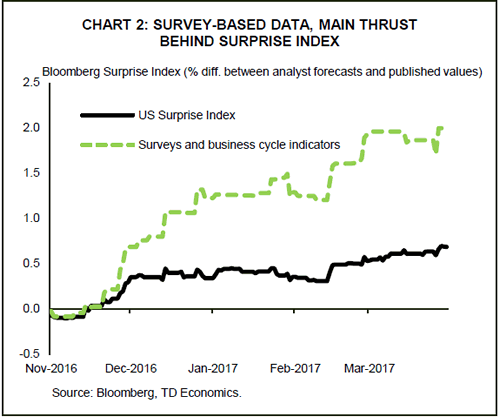
CANADA – GROWTH PICKING UP, POLOZ UNPERTURBED
What a difference a few months can make. There had been good reasons for cautious optimism in regards to the Canadian economy as we came into the tail end of 2016, but the economic performance in recent months has surpassed most expectations. This is best captured by the monthly GDP figures. The Canadian economy grew 0.6% month-onmonth in January, the best monthly performance in at least five years (excluding last June’s post-wildfire pop-back). Moreover, it marked a third straight expansion, with healthy growth recorded in both November and December (Chart 1).
To be sure, a few months’ worth of data does not a trend make. But, they can make a good starting point. Taking January’s GDP data into account pushes our tracking for first quarter growth to 3.4%, which would mark the strongest start to a year since 2013. There is, as always, reason to be cautious – business investment remains well below pre-2015 peaks and the sustainability of real-estate led strength and its support to consumer spending remains open to debate. On balance however, the near term Canadian growth outlook is looking the best it has in years.
The improvement in the near-term outlook has not, however, resulted in the return of "Sunny Stephen" Poloz. Rather, the Bank of Canada governor used the question and answer session of a speech this week to reiterate a cautious outlook, which was further reinforced in a magazine interview published today. The governor pointed out that the past three years have seen several bouts of improving economic data, but none have yet proved persistent. When asked about the monetary policy tightening in the United States, he pointed once again to what he suggests is relatively more economic slack in Canada.
While its size vis-à-vis the U.S. can be debated, there does appear to be economic slack in Canada at present. Economists commonly refer to the ‘output gap’ to measure the slack in an economy by estimating how far behind (or ahead) the economy is relative to its potential path (or where it would be in the absence of shocks). A negative output gap tends to be associated with a lack of inflationary pressures. While the output gap is inherently unobservable, still-soft underlying inflation, as measured by the Bank of Canada’s three core inflation measures, suggests that it remains below zero.
Indeed, The Bank of Canada’s estimates point to sizeable slack remaining in Canada, reinforcing the governor’s dovish tone (Chart 2). More importantly, the output gap does not appear likely to close any time soon. Taking the Bank of Canada’s estimates of potential GDP and combining them with TD Economics’ latest growth forecasts shows that the Canadian economy is unlikely to eat up its remaining economic slack this year. More likely is that the output gap closes some time in 2018. The bottom line is that, despite a brighter near term outlook, fundamental inflationary pressures are very soft at present, and so the continued dovish tone from the Bank of Canada should not be taken as a surprise. The most likely outcome remains a Bank of Canada that holds interest rates at 0.50% well into 2018.
